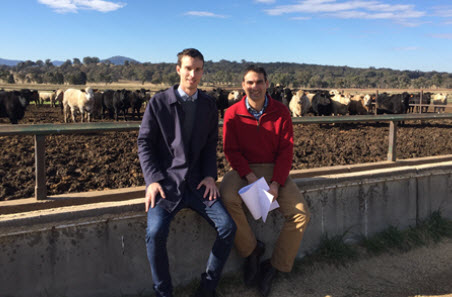How does heat impact meat quality?

The relationship between heat stress and dark cutting rates in grainfed cattle is the focus of a new project that will follow cattle through the supply chain to quantify the impacts on meat quality.
In consultation with the Australian Lot Feeders’ Association (ALFA), the grain-fed levy funded project is being led by Dr Peter McGilchrist from University of New England in collaboration with Professor Robyn Warner from University of Melbourne.
ALFA is also enabling capacity building within the industry by engaging University of New England PhD student Cameron Steel in the project. Cameron will be responsible for the collection, collation and analysis of the data.
Dark cutting rates higher in summer
Dr McGilchrist said dark cutting was typically a result of lower glycogen stores at slaughter, which can be caused by a range of factors. These include poor nutrition on-farm, stress or muscle contraction, which utilises glycogen as an energy source pre and post-farmgate.
“While grainfed cattle have typically greater glycogen stores compared to grassfed cattle and as a result, lower rates of dark cutting, there is anecdotal evidence for a greater incidence of dark cutting in feedlot cattle during summer,” Dr McGilchrist said.
“This could be the result of environmental impacts like heat stress, transport and time in lairage during hot weather.”
Meat colour is still used as a pricing mechanism on many domestic and export slaughter grids.
Dr McGilchrist said the project aimed to provide evidence-based solutions to non-compliance due to dark cutting. Research will analyse how it can be reduced in grainfed cattle during periods of heat stress, as well as implications and recommendations for post-slaughter time to grading.
“Theoretically, dark cutting shouldn’t really occur in grainfed cattle – the incidence of dark cutting in grainfed cattle should be about 1.5% or less – but in Australia, it runs at about 2.5–3%, and can spike to as much as 20%,” Dr McGilchrist said.
Research spanning the supply chain
“Dark cutting is a cost to both processors and producers and this project involves both sections of the supply chain working together.
“We want to look at what causes fluctuations in dark cutting across the year, and this will involve an intensive survey across a 12-month period with three processors, and eight supplying feedlots.
“Meat Standards Australia (MSA) also has a lot of historic grading data stored, which we will be analysing against historic environmental data recorded at individual feedlots to try and discover the impact of heat events on incidences of dark cutting.
“We also don’t know how long performance is affected by a heat event, so we’re looking at temperatures and impacts from about a month before slaughter.
“Weather stations are being installed in lairage and calibrated at feedlots to collect detailed environmental data across the supply chain.
“At the other extreme, we’ll be looking at the effects of cold shock on cattle in late autumn/early winter, which could have as big of an impact as heat stress.”
Taking all factors into account
Dr McGilchrist said the project also aimed to achieve a better understanding of the post-mortem metabolism in feedlot cattle and determine if it is compromised by heat stress.
“There is a tendency to think the cause of dark cutting happens before slaughter – however, the project will look at time to grading, blooming time and the economic impact of re-grading carcases,” Dr McGilchrist said.
“The effect of time to grading will be tested in grainfed carcases and the proportion of carcases that initially grade dark but become compliant with longer periods between slaughter and grading will be examined.
“Muscle samples will be collected from carcases defined as dark cutting at the time of grading, as well as from adjacent ‘normal’ colour carcases, and a metabolomic analysis of these muscle samples could be conducted. A cost analysis will be given on the economic benefit of managing the time to grading and re-grading of carcases.”
The project is underway and expected to take 18–20 months to complete.
More Information
Dr Peter McGilchrist
E: Peter.McGilchrist@une.edu.au



